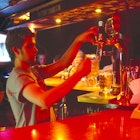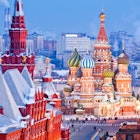
Dec 15, 2019 • 7 min read
A trip on the Trans-Siberian Railway takes a lot of planning. Here's our guide on what's needed before you go, and what to pack for the journey.

Dec 15, 2019 • 7 min read
A trip on the Trans-Siberian Railway takes a lot of planning. Here's our guide on what's needed before you go, and what to pack for the journey.

Nov 28, 2019 • 4 min read
Russia’s new day trains follow a triangular route connecting Petrozavodsk, Novgorod and Pskov. Here's our guide to visiting Russia's northwest by train.

Oct 28, 2019 • 5 min read
You've heard of Russian vodka, but do you know much about medovukha or samogon? Here's our guide to the drinks of Russia and the best places to try them.

Sep 25, 2019 • 7 min read
Explore the uneasy relationships of the Cold War period and Russia's role in contemporary world affairs at these political history and military museums.

Sep 23, 2019 • 7 min read
Susie Armitage recalls the bittersweet memories of her first journey on the Trans-Siberian railway, as she returns for a second trip, this time alone.

Sep 17, 2019 • 5 min read
Follow our top tips to find the very best shopping in Moscow, from malls and antique markets, to food stalls and Russian designs.

Sep 16, 2019 • 4 min read
Imagine solitude. The only sounds are of the natural environment: a river, the wind in the trees, your breath, and the birds chirping to one another. The only…

Sep 10, 2019 • 7 min read
Explore the art, architecture, and history of St Petersburg, Russia's cultural capital.

Apr 23, 2019 • 6 min read
One of the world’s largest cities, Moscow is a true metropolis whose ancient neighbourhoods are interspersed with newly built high-rises, inhabited by…

Dec 18, 2018 • 5 min read
Moscow has enough attractions to keep any traveller busy for a couple of weeks, but it would be a shame not to get out of the city and explore its…

Dec 11, 2018 • 5 min read
Chief Rabbi Berel Lazar has spent 2018 travelling across Russia to participate in ceremonies at a couple of historic synagogues. From the eastern Siberian…

Dec 11, 2018 • 5 min read
The word of the prophet Muhammad is believed to have arrived on present-day Russian territory early in the 8th century AD. Seven of Russia’s 22 republics…

Nov 27, 2018 • 6 min read
Germ-laden airports, upended sleep patterns and unfamiliar local bugs are just a few of the health risks travellers face when seeing the world. But…

Oct 4, 2018 • 5 min read
A single trip is nowhere near enough to truly appreciate the splendour of St Petersburg. But even a first-time visitor should consider a quick escape from…

Aug 10, 2018 • 6 min read
The Russian Far East has a mystique that’s been luring travellers for generations. With the volcanoes and geysers of Kamchatka, ancient stone pillars on…

Jul 3, 2018 • 5 min read
The few brief weeks of the White Nights – those incredible, luminous northern midsummer eves when the high latitudes are bathed in a pearlescent all-night…

May 26, 2018 • 4 min read
Believe it or not, in summer Moscow usually gets rather hot. It’s also the season when the city is fully awake, with more events happening than at any…

Mar 14, 2018 • 5 min read
You might imagine the Trans-Siberian as a lonely, melancholic train journey through a snowy plain. But it’s better visualised as a chain of really cool…

Feb 22, 2018 • 6 min read
Russia – the land of vodka, right? On first glance, the Smirnoff-swilling motherland might seem an unlikely beer destination. In fact, Russia has been…

Feb 13, 2018 • 4 min read
Among the Kremlin grandeur, tall Stalinist buildings and gorgeous onion-domed churches, it’s easy to overlook the Russian capital’s less famous sights…

Jan 18, 2018 • 6 min read
Throughout the 19th and 20th centuries Russia produced towering figures of world literature, including Pushkin, Chekhov, Tolstoy and Solzhenitsyn. Many of…

Jan 18, 2018 • 5 min read
One of Russia’s more surprising travel trump cards is the lip-smacking diversity of what’s cooked in its kitchens and served in its restaurants and cafes…